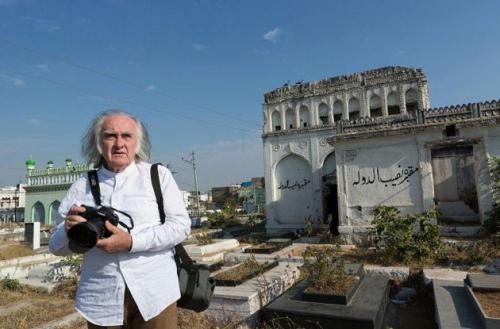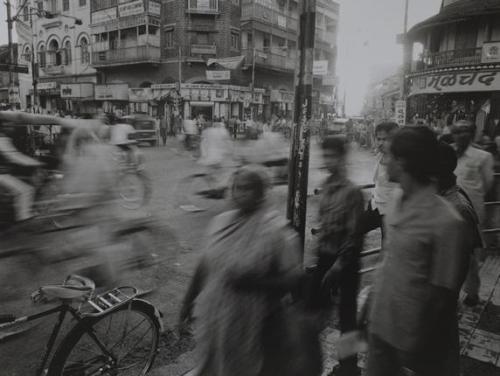
Following German photographer Thomas Luttge as he tramps through graveyards, in Hyderabad, looking for that munching goat and other unusual juxtapositions
“You cannot turn the cow,” says Thomas Luttge firmly. I am at an exhibition of his photographs at the Goethe Zentrum in Hyderabad. Even talented Western photographers have met their Waterloo in India. I’d asked him about his images, quite different from the usual cliché-ridden scenes. “Europeans come and look for the cows. Where are they cows? Oh here is a cow. And then they —”. Luttge shakes his head. “And there are photographers who do all kinds of tricks so the cow might turn and you can get the beautiful lines and the shape of the cow. I would never do that. I would say if the cow is like this, I have to accept it.”
Luttge, who bears an uncanny resemblance to Jeremy Bentham, moves with a spryness belying his seven decades. He has been coming to India since the 1960s. How does he avoid getting swamped by curious onlookers, I ask. “As a photographer, you are like an actor on the stage. So you have to develop something, you guide people and make them do what you want. I have trained myself in this way.”
We decide that I can tag along on one of his photographic explorations to Mir Momin ka Daira (a cemetery located in the old city).
Graveyard shift
Around us crowd thousands upon thousands of gravestones, islands in an ocean of death. At the heart lies Mir Momin Istrabadi’s tomb, who was a Persian and the original architect of Hyderabad. Luttge has been cataloguing the fate of Mir Momin’s city from his first visit here in 1975, believing that in Hyderabad the “tension of time stays open”. Like all photographers he is a scholar of the sun, a savant of the light. He approves of the morning glow around us. At this hour the necropolis is quiet. Some graves have fresh flower petals on them, the spoor of mourners.
A goat skips along munching on the flower petals, now on this grave, now on that, like a finicky guest at a buffet. Luttge, carrying both a digital camera and a medium-format camera with black-and-white film, immediately crouches down to try and frame the creature amidst a stone canopy that covers a grave. The goat suddenly grows self-conscious and leaps, even as he shoots. A quick glance at the screen. A shake of the head. “Too late,” he says. I point to more ruminants headed this way. He is not interested. Once a quarry escapes him, it escapes him forever.
Later we return to the Goethe-Zentrum. The exhibition is a distillation of half a century of work. The photographs span the globe — Morocco, China, Germany, New York. Some of the compositions are pervaded by a sense of dry humour. Humans are placed ironically. An empty Cola bottle is all that we see of humanity in a photo of a dense façade of Manhattan. Unusual juxtapositions of people and objects are a recurring motif in his work. “Life comes out of contradictions, life doesn’t come out of harmony,” says Luttge.
I examine the cityscapes — under louring skies, they seem like a photograph of a memory of a place rather than the place itself. They are in border zones between decay and growth, a kind of transitional space that reflects the semantic No Man’s Land that Luttge favours. This contrarian approach sometimes catches the viewer on the wrong foot. I pick up a catalogue and we leaf through his work. A nude pregnant woman on a beach. A souk in Morocco divided by brilliant shadows. A mist-shrouded river in Bangladesh. “I am asking something from the viewer. And, of course, for some viewers, this is also too much. They don’t want to be asked. They want to be served. The image should serve their feelings. Should serve their expectations. Should serve their dreams. And then they are happy. I don’t serve. I just offer.”

Luttge picked up his first camera at age 12, shooting images of his garden in the family house outside Munich. Fifty years on he is still at it. The journey hasn’t been easy. “I sit at home and write hundreds of emails,” he says, looking for funders, looking for exhibition space. Ninety-eight per cent of them lead to nothing. Working in his darkroom, he can at most make one to three prints a day. “These are all originals,” he says. “They are all made in my own darkroom. I did them with all these chemicals, the same way as I did, 50 years ago. And here you get this quality which you can never get elsewhere.” Now even the photographic paper that he prints his work on is going extinct. “This is my life, there is never any guarantee,” he says. Now he is busy compiling his latest images of Hyderabad to be exhibited in Berlin later this year.

To Luttge, whenever you pick up the camera, as much as you turn it outwards, you are also turning it inward into the shadowy recesses of the self. The landscapes of the interior are as mysterious as those that can be found in the outer world.
Jaideep Unudurti is a writer and the founder of the Hyderabad Graphic Novel project
source: http://www.thehindubusinessline.com / Business Line / Home> Features> Blink / by Jaideep Unudurti